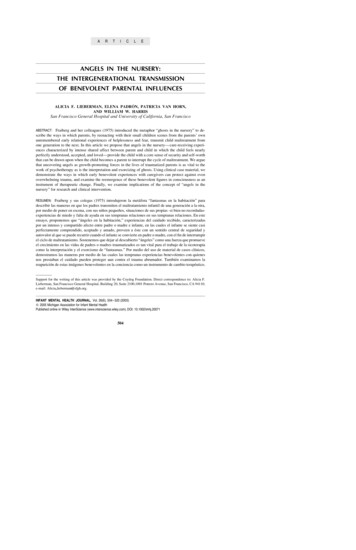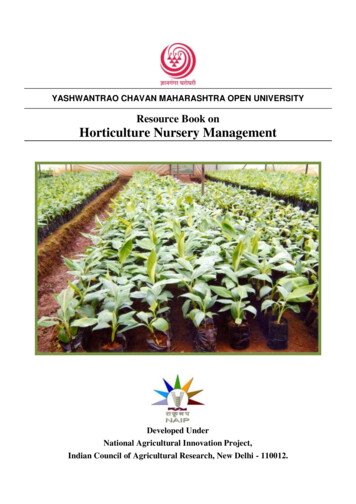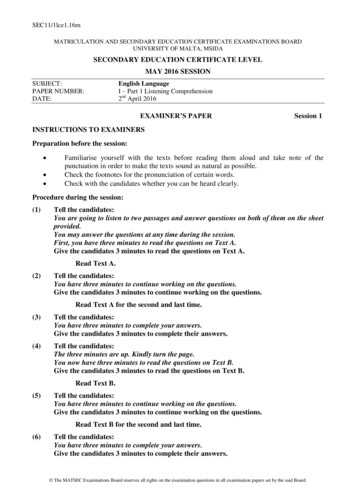
Transcription
IMHJ (Wiley)LEFTBATCHtop of AHARTICLEANGELS IN THE NURSERY:THE INTERGENERATIONAL TRANSMISSIONOF BENEVOLENT PARENTAL INFLUENCESALICIA F. LIEBERMAN, ELENA PADRÓN, PATRICIA VAN HORN,AND WILLIAM W. HARRISSan Francisco General Hospital and University of California, San FranciscoABSTRACT: Fraiberg and her colleagues (1975) introduced the metaphor “ghosts in the nursery” to describe the ways in which parents, by reenacting with their small children scenes from the parents’ ownunremembered early relational experiences of helplessness and fear, transmit child maltreatment fromone generation to the next. In this article we propose that angels in the nursery—care-receiving experiences characterized by intense shared affect between parent and child in which the child feels nearlyperfectly understood, accepted, and loved— provide the child with a core sense of security and self-worththat can be drawn upon when the child becomes a parent to interrupt the cycle of maltreatment. We arguethat uncovering angels as growth-promoting forces in the lives of traumatized parents is as vital to thework of psychotherapy as is the interpretation and exorcizing of ghosts. Using clinical case material, wedemonstrate the ways in which early benevolent experiences with caregivers can protect against evenoverwhelming trauma, and examine the reemergence of these benevolent figures in consciousness as aninstrument of therapeutic change. Finally, we examine implications of the concept of “angels in thenursery” for research and clinical intervention.RESUMEN: Fraiberg y sus colegas (1975) introdujeron la metáfora “fantasmas en la habitación” paradescribir las maneras en que los padres transmiten el maltratamiento infantil de una generación a la otra,por medio de poner en escena, con sus niños pequeños, situaciones de sus propias -si bien no recordadasexperiencias de miedo y falta de ayuda en sus tempranas relaciones en sus tempranas relaciones. En esteensayo, proponemos que “ángeles en la habitación,” experiencias del cuidado recibido, caracterizadaspor un intenso y compartido afecto entre padre o madre e infante, en las cuales el infante se siente casiperfectamente comprendido, aceptado y amado, proveen a éste con un sentido central de seguridad yautovalor al que se puede recurrir cuando el infante se convierte en padre o madre, con el fin de interrumpirel ciclo de maltratamiento. Sostenemos que dejar al descubierto “ángeles” como una fuerza que promueveel crecimiento en las vidas de padres o madres traumatizados es tan vital para el trabajo de la sicoterapiacomo la interpretación y el exorcismo de “fantasmas.” Por medio del uso de material de casos clı́nicos,demostramos las maneras por medio de las cuales las tempranas experiencias benevolentes con quienesnos prestaban el cuidado pueden proteger aun contra el trauma abrumador. También examinamos lareaparición de estas imágenes benevolentes en la conciencia como un instrumento de cambio terapéutico.Support for the writing of this article was provided by the Coydog Foundation. Direct correspondence to: Alicia F.Lieberman, San Francisco General Hospital, Building 20, Suite 2100,1001 Potrero Avenue, San Francisco, CA 94110;e-mail: Alicia"lieberman@sfgh.org.INFANT MENTAL HEALTH JOURNAL, Vol. 26(6), 504– 520 (2005)! 2005 Michigan Association for Infant Mental HealthPublished online in Wiley InterScience (www.interscience.wiley.com). DOI: 10.1002/imhj.20071504shortstandardbase of drop
IMHJ (Wiley)RIGHTBATCHAngels in the Nursery 505Finalmente, examinamos las implicaciones del concepto de “ángeles en la habitación” en cuanto a lainvestigación y la intervención clı́nica.top of rhbase of rhcap heightbase of textRÉSUMÉ: Fraiberg et ses collègues (1975) ont été les premiers à présenter la métaphore “fantômes dansla chambre d’enfant» pour décrire les manières dont les parents, en reproduisant avec leurs enfants enbas âge des scènes de leurs propres expériences inconscientes relationnelles d’impuissance et de peur,transmettent un mauvais traitement d’une génération à l’autre. Dans cet article, nous proposons que lesanges dans la chambre d’enfant, des expériences de mode de soin caractérisées par un affect intensepartagé entre le parent et l’enfant durant lequel l’enfant se sent presque parfaitement compris, accepté,aimé, offre à l’enfant un sens fondamental de sécurité et d’estime de soi qui peut être retrouvé lorsquel’enfant devient parent, pour interrompre le cycle de mauvais traitement. Nous pensons que le fait dedécouvrir ces anges en tant que forces de promotion de croissance dans les vies de parents traumatisésest tout aussi crucial pour le travail de psychothérapie que l’est l’interprétation et l’exorcisme des fantômes. En utilisant des cas cliniques, nous démontrons les manières dont de bonnes expériences précocesavec des modes de soin peuvent offrir une protection contre les traumas, mêmes les plus accablants, etnous examinons la réapparition de ces êtres bienveillants dans la conscience comme un instrument dechangement thérapeutique. Enfin, nous examinons les implications du concept d’«anges dans la chambred’enfant» pour les recherches et l’intervention clinique.ZUSAMMENFASSUNG: Fraiberg und Kollegen haben 1975 die Metapher: Geister im Kinderzimmer ein-geführt, um die Art zu beschreiben in der Eltern – indem sie mit ihren kleinen Kindern Szenen derHilflosigkeit und der Angst wieder inszenieren –, die aus den nicht erinnerten frühen Beziehungserfahrungen stammen, Misshandlung von einer Generation zur nächsten weitergeben. In dieser Arbeit schlagenwir den Engel im Kinderzimmer vor: Betreuungserfahrungen, die sich durch intensiv gemeinsam empfundene Gefühle zwischen Eltern und Kind auszeichnen bei denen sich das Kind fast ideal verstanden,akzeptiert und geliebt fühlt. Dies gibt dem Kind ein grundlegendes Gefühl der Sicherheit und Selbstwertauf das zurückgegriffen werden kann, wenn das Kind selbst Eltern wird, um den Zyklus der Misshandlungzu unterbrechen. Wir behaupten, dass die Entdeckung von Engeln als Wachstumsfaktoren im Lebentraumatisierter Eltern ebenso in der psychotherapeutischen Arbeit lebenswichtig ist, als die Interpretationund das Exorzieren von Geistern. Durch Verwendung von Fallgeschichten demonstrieren wir den Wegin dem frühe, hilfreiche Erfahrungen mit Bezugspersonen sogar gegen ein überwältigendes Traumaschützen können und überprüfen das Wiederauftreten dieser hilfreichen Figuren im Bewusstsein als einInstrument der therapeutischen Veränderung. Zuletzt untersuchen wir das Konzept der „Engeln im Kinderzimmer“ im Hinblick auf Forschung und klinische Intervention.shortstandard
IMHJ (Wiley)506 LEFTBATCHtop of rhbase of rhA.F. Lieberman et al.cap heightbase of text***A grandfather observes from a distance while his son, a young father, attends tenderly tohis own new baby. The joy he feels in watching them brings back a scene from long ago,when a surge of happiness washed over him as he looked at his wife playing lovingly withtheir then small son. Finding himself thinking at once about the present and about the past,he muses: “There are angels that pass on from one generation to another, but they are seldomnoticed or talked about” (Harris, personal communication, April 23, 2003).In reliving this moment, the grandfather came to the deep realization that his son’s delighted ease in ministering to the baby carried the imprint of the loving parenting his son’smother had herself received as a child. The scene had evoked for him the memory of his wife’stender mothering of their son and then led him to reminisce about the deep bonds between hiswife and her mother. In this sequence, the seemingly unremarkable scene of a father caring forhis baby becomes the carrier of the profoundly important protective intergenerational influencesthat foster the healthy development of children everywhere. In being observed, the scene alsoshows us four generations coming together, each with a very special role, in celebrating parent –child relationships.In the spiritual tradition of many cultures, angels are benevolent spiritual beings whomediate between heaven and earth, acting as messengers from the divine and often serving asprotective guardians (Murray, 1971). We propose that from a psychological perspective, angelsemerge from childhood memories deeply connected to the phenomenology of care-receivingexperiences that are characterized by intense shared affect between parent and child and providethe child with a core sense of worth and security. These messages of intrinsic goodness andunconditional love constitute the essence of the angel. As they enact scenes from their ownpast, parents unknowingly carry forth the angels from their childhoods into their babies’ nurseries. In this way, the message of the “angels in the nursery” is transmitted to the next generationin the form of benevolent influences that guard the course of development.In ideal circumstances, self-affirming influences move silently in the lives of children,wrapping each successive generation in the security that comes from being loved, accepted,and understood. In darker moments, these “angels in the nursery” square off against their morefamous siblings, the ghosts (Fraiberg, Adelson, & Shapiro, 1975), doing battle with them tokeep intact the protective shield of parental love that surrounds young children and endeavoringto repair the damage when malevolent influences from the past break through. Ghosts andangels coexist in dynamic tension with each other, at times actively struggling for supremacyand at other times reverting to a quiescent state that allows the person to temporarily inhabit a“conflict-free ego sphere” (Hartmann, 1939) where adaptation to the external world takes precedence over intrapsychic preoccupations. Their host may or may not be consciously aware oftheir presence or their meaning because emotional states and frames of mind are usually feltin the moment, without reference to their origin in the person’s past experiences.In this article, we examine the chiaroscuro of ghosts and angels in the nursery movingtogether to shape the development of children, and argue that the uncovering of angels asgrowth-promoting forces in the lives of traumatized parents is as important to therapeutic workas the containing, taming, and exorcizing of ghosts. Our clinical experience indicates that therecovery and integration into consciousness of early experiences of safety, intimacy, joy, andshortstandard
IMHJ (Wiley)RIGHTBATCHAngels in the Nursery 507other pleasurable experiences can promote a more nuanced appreciation of early relationshipswith primary caregivers and encourage a greater sense of self-worth and emotional investmentin developmentally appropriate goals. This enlarged therapeutic perspective is relevant to thetreatment of traumatic stress, which currently emphasizes a therapeutic focus on traumaticreminders and other triggers that blur the boundaries between remembering a traumatic eventand reliving it (Marmar, Foy, Kagan, & Pynoos, 1993; Pynoos, 1997; Pynoos, Steinberg, &Piacentini, 1999). We propose that the parallel identification of “beneficial cues” (Harris, 2004)can hasten recovery from trauma by placing the traumatic cues within the larger perspectiveof nurturing and growth-promoting experiences. Our goal is to create a counterbalance for theprevailing tendency of relationship-based interventions in infancy to either focus primarily oncurrent parent – child interactions or to explore the parent’s early experiences of pain, conflict,and alienation from caregivers (see Osofsky, 2004; Sameroff, McDonough, & Rosenblum,2004; Stern, 1995). When the emotional polarities associated with early conflictful and benevolent experiences is brought to consciousness, object constancy can be attained and results inincreased emotional integration and tolerance for ambivalence (Mahler, Pine, & Bergman,1975). The recovery and full reexperience of loving early memories is an indispensable firststep in this process.In developing our thesis, we begin by reviewing Fraiberg et al.’s (1975) formulation ofghosts in the nursery. In the sections that follow, we expand on the parallel concept of angelsin the nursery, first exploring the ways in which parents recover a connection with thesebeneficent forces in their early lives. We then describe the ways in which early benevolentexperiences with caregivers can work as protective forces even in the face of overwhelmingtrauma. Finally, we examine the reemergence in consciousness of these benevolent experiencesas a powerful instrument of change in the therapeutic process. We conclude by examining someimplications of the concept of “angels in the nursery” for research and clinical intervention.The clinical material was gathered from child – parent psychotherapy with an ethnically andsocioeconomically diverse sample of children aged from birth to 6 years and their parents. Thechildren were referred because of symptoms associated with witnessing domestic violence, physical abuse, or traumatic bereavement. All the parents were exposed to traumatic stressors asadults, and for approximately half of the parents, the traumatic experiences began in childhood.Parenting difficulties in this group were pervasive and took the form of severe conflicts in thechild – parent relationship (Lieberman, 2004; Lieberman & Van Horn, 1998). We reviewed clinical charts containing narrative notes of therapeutic sessions and assessment protocols that included transcripts of the Adult Attachment Interview (George, Kaplan, & Main, 1996), a quasiclinical interview where responders are asked to describe their childhood experiences with theirparents. In the course of forming a therapeutic relationship, we asked parents to reflect on theirearly years, their relationships with their parents, and their thoughts on how these experiencesinfluenced their hopes for their children’s future. We examined parental narratives in assessmentinstruments and clinical notes to identify early experiences of love, care, and nurturing that mightstand out as sources of strength in the parents’ sense of themselves and ability to care for theirchildren. In the course of the study, some of the clinicians were moved by the image of angelsin the nursery to write down their memories of personal experiences evoked by this concept. Allthe examples have been modified to protect confidentiality.top of rhbase of rhcap heightbase of textGHOSTS IN THE NURSERY: IDENTIFICATION WITHTHE AGGRESSORThe image of ghosts in the nursery has become a metaphor of unsurpassed power since SelmaFraiberg coined it nearly 30 years ago to describe the parents’ excruciating enactment withshortstandard
IMHJ (Wiley)508 LEFTBATCHA.F. Lieberman et al.their small child of scenes from the parents’ own unremembered, but still painfully influential,early experiences of helplessness and fear (Fraiberg et al., 1975). The ghosts, representing therepetition of the past in the present, acquire corporeal form through punitive or neglectfulcaregiving practices. The parent fails to recognize the meaning of the child’s signals of need,either ignoring or misconstruing them as evidence of the child’s inherent badness and responding with anger and rejection. In these instances, the immediacy of the parent’s visceral reactiontakes precedence over the baby’s developmental needs. As the recipient of the parent’s negativeattributions, the child progressively internalizes a sense of self as unworthy and undeservingof love that can derail the course of healthy development (Bowlby, 1980; Lieberman, 1997,2000; Silverman & Lieberman, 1999).In her seminal work with mental health disorders in infancy, Fraiberg (1980) attributedthe havoc caused by the ghosts of the parental past not to the actual events but to the repressionof the affects associated with terrifying early memories. She viewed repression and isolationof affect as providing “motive and energy” for the enactment of punitive caregiving patternsthat represent “identification with the betrayers and the aggressors” (pp. 134 – 135). Whenenacted between parent and child, identification with the aggressor is formed to protect thevulnerable ego from external attack by acquiring the feared characteristics of the attacker (A.Freud, 1936/1966; Pynoos, 1997). The abused becomes the abuser because perpetrating painis used as a protection against feeling it.While providing the basis for influential clinical interventions, this theoretical model leavesunaddressed the question of why many parents do not repeat with their children the patternsof abuse and neglect they were subjected to while growing up. As expressed by Fraiberg (1980),the “unresolved mystery is why, under conditions of extremity, in early childhood, some children . . . do not make the fateful alliance with the aggressor” (p. 135). In the quarter centurysince she posed this question, the challenge of pinpointing how individual differences accountfor the vast variety of responses to similarly traumatic circumstances remains a lively area ofexploration. In our clinical work with children and their parents traumatized by exposure tovarious forms of interpersonal violence, we have observed a broad range of parental response,from anger at the traumatized child to an exquisite attunement to the child’s suffering anddetermination to restore the child’s emotional health. A similar range of parental responses hasbeen reported in nonclinical settings where the plight of traumatized children is brought to theattention of the authorities such as law enforcement (Osofsky, Hammer, Freeman, & Rovaris,2004), the child protective system (Smyke, Wajda-Johnson, & Zeanah, 2004), and the courts(Osofsky & Lederman, 2004; Van Horn & Hitchens, 2004).Parental anger at the child in need can often be understood in light of the “ghosts in thenursery” model. But what are the influences on parents who, despite their own childhoodtraumas, protect their child from a repetition of the past? We hypothesized that if we were ableto identify these influences, we might be able to incorporate them into the repertoire of therapeutic techniques that enable maltreating parents to find empathy with their children’s vulnerability and to discover their crucial role as the child’s protectors.top of rhbase of rhcap heightbase of textANGELS IN THE NURSERY: THE TRANSMISSION OFNURTURING EXPERIENCES IN EARLY DEVELOPMENTThe pivotal role of human relationships in shaping the sense of self, beginning at birth withthe mother – child bond, has been extensively elaborated. The importance of caregiver emotional availability and empathic responsiveness in helping the infant and young child to regulateaffect and organize internal experience is a recurrent theme in these investigations, and effortsto describe the specifics of these processes have yielded terms that have become the coins ofshortstandard
IMHJ (Wiley)RIGHTBATCHAngels in the Nursery 509the realm in describing different facets of these early interpersonal-affective experiences suchas “mirroring” (Winnicott, 1971), “attunement” (Stern, 1985), “containment” (Bion, 1962),“security” (Ainsworth, Blehar, Waters, & Wall, 1978), “felt security” (Sroufe & Waters, 1977),“refueling” (Mahler & McDevitt, 1982), “secure base” (Ainsworth et al., 1978), and “mentalization” (Fonagy, Gergely, Jurist, & Target, 2002), among many others. All these terms sharethe virtue of evoking in the reader an intuitive sense of their meaning, despite their highlytechnical definitions. In this sense, they do justice to the visceral quality of the processes theydescribe. Moments of particular connectedness, characterized by mirroring and intense sharedaffect, are not merely growth-promoting but become an integral part of the child’s identity.Kohut (1971) used the term “transmuting internalization” to describe the process by whichinterpersonal experiences become incorporated into self-experiences.Phenomenologically, specific instances of these exchanges may be remembered as moments of heightened intimacy between parent and child, when the child felt (almost) perfectlyunderstood, accepted, and/or protected. This allows for moments during which the interactionmay unfold as if in an effortless dance where each partner unselfconsciously anticipates andresponds to the moves of the other. Sometimes these experiences do not occur with the parentbut with another adult who is seen as providing the kind of unconditional care that is notavailable from the parents, as shown in the following edited excerpt.top of rhbase of rhcap heightbase of textMy aunt . . . she was just always a very gentle, very loving. . . . . she’d brush my hairvery gently and never pulled my hair, like my mom did. My mom was always in a hurry toget the hair brushed . . . get it over and done with, and my aunt would just take her time,and be so gentle. . . . She was like a warm blanket, she was just wonderful. . . .The body-centered quality of these memories highlights the centrality of preverbal andnonverbal experiences in creating an enduring sense of well-being. The integration of bodilyexperiences is a primary building block in defining the physical boundaries of the self and itsrelationship with the world because the parent’s recognition of the baby’s physical and emotional needs is expressed nonverbally starting at birth and is a prerequisite for effective symbolization (Dennett, 1978; Stern, 1985). The following edited excerpt illustrates the enduringimportance of nonverbal communication in evoking a sense of belonging together in a relationship.Everything about my dad just was warmth. I mean, you just walked into his presence andyou just felt like smiling. He used to like to sit on the couch when he’d get home and readthe newspaper, put his feet up . . . he always had his arm like this, like arched around, andit was like that was your spot, and he’d just wait for you to come.This narrative conveys a strong sense of being unconditionally embraced by the loving father.This is not to say that a parent’s behavior must be perfectly attuned to the child’s needs at alltimes. One mother spoke of her father as a man for whom it was not easy to spontaneouslyconvey love for his child: “He didn’t know how to express himself. He could be loving, but itwas hard for him to express it. That’s when you’d get the card that would say ‘I know I don’texpress myself much, but. . . .” In this example, the father’s insightfulness regarding hisdifficulty in expressing feeling allowed room for negotiation and repair, and generated in hisdaughter a grateful acceptance of the father’s limitations and of his effort to overcome it. Thisshortstandard
IMHJ (Wiley)510 LEFTBATCHA.F. Lieberman et al.recollection is reminiscent of the finding that a very high degree of maternal responsiveness tothe infant’s signals in the first months of life is associated with later anxious attachment whereasmedium levels of coordination are optimal for secure attachment and easygoing temperament(Beebe & Lachman, 2003). Repairing mismatched communications may be as valuable increating the capacity for intimacy as impeccably empathic parental responsiveness to the child’ssignals (Tronick, 1998). This process of recognition and repair in the development of the selfis not restricted to infancy and early childhood but may continue throughout the lifetime, asshown in the following excerpt.top of rhbase of rhcap heightbase of textWhen my son was born, I immediately took to singing to him. One day, as I was rockinghim to sleep and trying to remember the lyrics to favorite songs from my childhood, I foundmyself singing the ‘I found a peanut’ song while I cuddled him, gently rubbing his back andsmelling his sweet scent. Instantly, I remembered sitting in my mother’s lap in the rockingchair in our small den as a young child, hearing my mother sing the lyrics to this song as Isnuggled against her, feeling tired but comforted and soothed in my sickness at the time. Ithen remembered several gentle, loving moments with her comforting me when I was sick,holding me, loving me.Akin to the unknowing replaying of ghosts described by Fraiberg and colleagues (1975),there is an effortless recapitulation of loving interpersonal exchanges that brings back memorieslong forgotten. The mother in this case was not reflecting on her own past to remember scenesfrom her childhood. She “finds herself” singing, which “instantly” pulls with it the associatedimages of her being cuddled by her own mother. What is described here is not a vague senseof having being loved but rather specific moments, woven with recollections of sensory experience, expressed in words such as “warm,” “cuddly,” “rocking,” and “smelling his sweetscent.” The narrative brings us back to the present as she goes on to describe the intergenerational effect of such experiences.These moments came full circle for me when my parents were visiting three weeks after myson was born. During the one night of his early months that he cried incessantly through thenight, I was at my wits’ end trying to soothe him with my own songs and rocking him.Nothing was working. My mother woke up and came in, asking if she could help. I willinglyoffered him to her, and she began rocking and singing to him in much the same way that Ihad been doing for the last few weeks. I felt warmed by her ability to tolerate his cries andattend to him so lovingly, realizing she had done this many nights with me when I was little.I felt joined with her that night in a surprising, delightful way as we shared in the experience — both the trials and delights — of mothering across generations. I realized she had thiscapacity to offer unconditional love to me in times of distress, sickness, or injury, if not inthe conditions of everyday life. . . . Despite my continued sadness over what she didn’tgive me emotionally growing up, becoming a mother and finding myself enacting some ofthe moments of love and delight with my son that I know my mother had with me feels likea gift that she gave to me in helping me develop a sense of trust and comfort with others.When this young woman recalls her childhood memories and connects them with theforgotten affect that accompanied them, she is able to recognize the effect that such experienceshad on her. Fraiberg (1980) described the process whereby ghosts in the nursery might preventa mother from hearing her baby’s cries, due to her own unmet childhood needs. Like ghosts,angels deal with the particulars of life and etch themselves into memory and personality, leadingshortstandard
IMHJ (Wiley)RIGHTBATCHAngels in the Nursery 511to an identification with the parent that provides “motive and energy for repetition.” One youngmother described herself as having a sense of “déjà vu” when dancing with her baby acrossthe room. She felt herself as a baby and as a mother at the same time, leading her to reflectthat she was now repeating with her baby a pattern learned long before she could speak.top of rhbase of rhcap heightbase of textANGELS IN A TRAUMATIC PAST: IDENTIFICATIONWITH THE PROTECTORThe traumatized parents and children that we treat manifest a broad range of reactions to theirlife experiences. Some of the parents grimly reenact the troubled experiences of their past withtheir own children. A large number are empathic with their children despite the hardships theyhave endured. As postulated by Fraiberg and colleagues (1975), many of these empathic parentshave access to memories of painful early affect, which makes them attuned to their child’s fearand sadness and motivates them to change the child’s life for the better.This sequence, however, is not always in place. Many parents vividly describe abusiveand neglectful acts perpetrated against them and retrieve memories of the intense terror theyfelt at the time, but this does not lead to improvements in their parenting of their child. Theaffect, while not repressed, does not serve to enhance parental emotional resonance with thechild’s affect.In such cases, the child may instead come to represent figures from the parent’s childhoodon whom the parent projects unacceptable and disavowed feelings of hatred and rage (Lieberman, 1997, 2000; Silverman & Lieberman, 1999). Particularly during affectively charged interactions, the parent does not see the child as a separate person whose behavior is motivatedby individualized internal states but reacts as if the child were a participant in the parent’smemory (Fonagy, Target, Steele, & Steele, 1997). In so doing, the parents limit their abilityto adapt flexibly to the child (Cicchetti & Tucker, 1994). The child, in turn, becomes frightenedby a parental response that is incompatible with his or her own inner state, and is left illequipped to understand and modulate feelings or to empathize with others. This process mayset in motion the first steps in relationship disorders and the perpetuation of psychopathologyfrom one generation to the next.Our review of clinical interviews and narrative notes of child – parent psychotherapy sessions suggests that traumatized parents who can mobilize themselves to alleviate their child’sfear and pain tend to have access not only to their early feelings of vulnerability but also tomemories of feeling cared for and protected by a benevolent attachment figure. These earlynurturing experiences alleviated terror, offered hope, and provided an alternative model ofintimate relationships as a source of comfort and security. Instead of having no recourse butidentification with the aggressor to feel secure, these parents could model themselves after“angels in the nursery” perceived as both powerful and benign. This process resulted in ahealth-promoting “identification with the protector.” The child’s internalization of the caregiver’s qualities that evoked feelings of being loved and va
Angels in the Nursery 507 IMHJ (Wiley) RIGHT BATCH short standard top of rh base of rh cap height other pleasurable experiences can promote a more nuanced appreciation of early relationships base of text with primary caregivers and encoura










